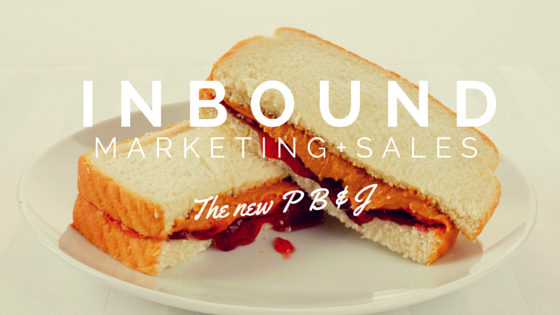Inbound Marketing and Inbound Sales: the new peanut butter ‘n’ jelly
If you read our blog regularly or follow Rep Ink on social media, you know that our entire team went to HubSpot’s annual INBOUND conference in Boston last month. The conference is the largest event dedicated to the art of inbound marketing (often also called content marketing, although that’s subject to lots of debate). Whatever term you prefer, this is the practice of creating quality content that attracts people to your company rather than the old outbound “interruption” method of cold calling, advertising, buying email lists and praying for leads and sales.
So, why, over and over again, did I keep hearing about sales?
According to HubSpot’s State of Inbound 2014 — a survey of thousands of marketers — the era of “inbound selling” has arrived. According to the report: “Inbound is no longer limited to ‘just’ marketing. More than 25 percent of respondents reported that their organizations’ sales teams practice inbound, and it’s not just lip service.”
The problem (?), it turns out, is that inbound marketing works. It generates leads. Leads are those pesky visitors who come to your website and fill out forms to access your super-valuable content — e-books, webinars, infographics, tenda gonfiabile videos and more. And these aren’t the kinds of leads that your “outbound” salespeople are used to. These leads are interested in what you’ve got to offer. They’ve sought you out proactively and have a need that you can fulfill. They might not be ready to buy now, but there is some sort of interest, or they wouldn’t be on your site filling out your form.
Let’s Marvin Gaye and get it on
As any marketer or sales rep knows, marketing and sales have traditionally been at odds in many companies, each using the other as scapegoats if targets aren’t met. Fingers cocked and loaded, sales accuses marketing of not serving up quality leads, marketing accuses sales of not closing the leads it provides.
According to HubSpot’s research, inbound leads are eight times more likely to close into customers than outbound leads. This, in addition to the Aberdeen Group’s research showing that companies with strong sales and marketing alignment enjoy 20-percent higher annual revenue growth, and it’s hard to see why more companies aren’t forcing their marketing and sales folks to, well, you know, align for goodness sake.
It’s the ‘cold’ that’s dead, not the ‘calling’
 But inbound marketing is new. Sales professionals are used to old, outbound tactics. What should they do with your newfangled inbound leads? Should they call these leads? When should they call them? How many times?
But inbound marketing is new. Sales professionals are used to old, outbound tactics. What should they do with your newfangled inbound leads? Should they call these leads? When should they call them? How many times?
According to Hubspot, if your company is generating 150 leads per salesperson per month, then you should be calling and/or emailing every single one of those leads.
But wait!
All you savvy inbound marketers out there: I know what you’re thinking. All inbound leads aren’t created equal.
One lead might be thinking, “I want a demo!”
Another, “my budget’s not defined.”
“I don’t have a timeline.”
“Sorry, not the right person.”
“Just doing research.”
The list goes on.
That’s fine. Your salesperson will do the qualifying (figuring out where your lead is in the buying journey) for you. Once the salesperson figures that out, because, say, the lead doesn’t respond to a phone call or says they are just doing some research, that’s where your lead nurturing takes over. Once the salesperson understands the lead’s current lifecycle stage, he can determine the right next step — call the prospect again or start lead nurturing to provide more valuable content until the lead is ready to buy.
What if you’re generating more than 150 leads per salesperson per month? Use lead scoring to help identify the leads most likely to buy and prioritize those for phone calls. For the rest, use automated lead nurturing to ensure you don’t drop the ball on the diamonds in the rough.
Always be closing helping
 HubSpot recommends the following process:
HubSpot recommends the following process:
A human (not an automated process) salesperson should call a lead at least two times. If the salesperson connects, he schedules the next call or adds the lead to a lead-nurturing program/automated email workflows (depending on the outcome of the connection — for example, he might find out that the lead is not ready to buy and needs more nurturing). If the salesperson never connects after reaching out twice, the lead goes into a lead-nurturing program.
What should the salesperson say? He should reference the fact that the lead downloaded the content, and then he should offer more value and be helpful:
Hi Mark: I was notified that you came to our website and recently downloaded our e-book. I’ve researched your company and have another report we’ve developed that I think would be helpful for you. But first I wanted to understand what you were looking to learn more about and how I can be a resource to you. Do you have a few minutes to talk further?
See how it always come back to helping? That’s what I love about inbound marketing — you’re just helping people. That’s why it’s critical that your sales team has access to and understands the helpful resources your marketing team is developing so your salespeople can use them in the most effective way possible.
Have you implemented inbound sales at your company? Let me know about the lessons you’ve learned in the comments below or email me at michelle@rep-ink.com.









